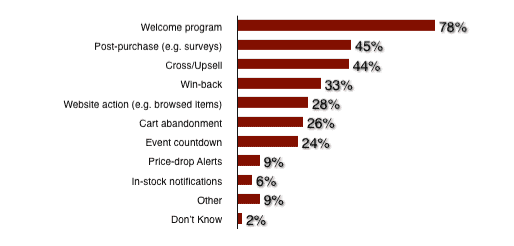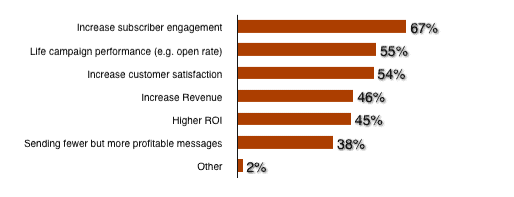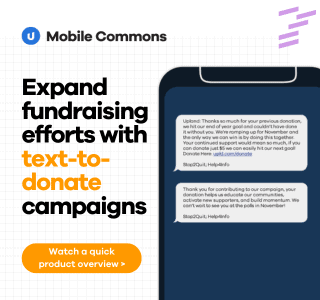In what’s definitely a common theme in mobile marketing, email marketers have once again been kind enough to pass along some best practices to their mobile counterparts. A recent report from eMarketer detailed the following stats with regards to customer lifecycle email campaigns:
Lifecycle Email Marketing Programs Being Used By Companies Worldwide, June 2011

Benefits of Lifecycle Email Marketing Programs, From Companies Worldwide, June 2011

For those foreign to email marketing terms, “lifecycle email marketing” is the practice of triggering automated emails in response to various consumer actions. As you can see from the first graph, examples of this practice are sending a welcome email when a person signs up for a particular product or service, or notifications when people forget to click “purchase” on a well stocked online shopping cart (another m-lesson btw).
Lifecycle email marketing campaigns contrast with general programs like email blasts, where customers receive updates from brands without performing a specific action. The study reported 75% of companies believing lifecycle campaigns outperform blasts, which to me is no surprise given that we’re talking about pull (lifecycle) vs. push (blasts) marketing. In today’s world, B2C communication is becoming more and more about basic human interaction, where rude interruptions are scorned. For push marketing to work, brands need to be savvy enough to interrupt without seeming uninvited, and not everyone has the same skill set as the Grey Poupon guy.
So on to our objectives for developing a lifecycle mobile marketing strategy:
#1 Identify The Lifecycle Strategies You Need For Your Brand
The first objective for mobile marketers is to take a look at each of the strategies listed in the first graph and think about how to integrate them into your mobile messaging strategy. We’ve already mentioned mobile’s advantages for cart abandonment, but mobile’s immediacy and interactivity are particularly useful for concepts like price alerts, surveys and timely notifications. Lifecycle mobile communication will have the same benefits as email when done correctly, including the all important customer satisfaction, revenue, and ROI you see in the second table.
For those still overwhelmed, think about all the ways that consumers interact with your product or service. Examples could include making a purchase, downloading resources, or posting a comment to your site. Each one of these interactions is an opportunity to launch a lifecycle mobile campaign. And don’t worry about the technology. Any lifecycle campaign you can think of is most likely easily achieved with an API call, so think big and think mobile.
#2 Think Cross Channel
In addition to developing an idea of the types of mobile lifecycle campaigns you want to launch, you’ll want to consider how cross-channel communication fits into your vision. Today’s successful technology companies never forget to empower consumers to make choices, and communication is no different.
Two things to keep in mind. First is that cross-channel communication is about providing multiple touchpoints with the consumer at the center. For example, a welcome email works great, but what other cross channel options might be more beneficial? How about an SMS welcome text (e.g. if your customer came from your mobile website) with a link that triggers an authenticated welcome email to your customer’s email inbox? Now you have a subscriber on your mobile list, you’ve prevented email from going to a spam filter, and you have an email subscriber – all from a single interaction.
The second is giving consumers a choice. It stems from the same reason push notifications aren’t as effective as pull. Consumers today are sufficiently empowered and technologically savvy that they should be able to decide the channel they prefer for mobile communications. Take for example two individuals who love the same brand of jeans: one travels everywhere and another spends time at a desk with little to no cell reception. Clearly these two individuals will desire different communication channels from the company that makes their clothing.
#3 Mind Your CRM
To reiterate: a mobile lifecycle marketing strategy is automated mobile communication responses to various consumer actions. Guess what that means – you learn something about your consumer every time you send a lifecycle marketing message. What’s important is that you approach each of these messages with a CRM mindset in order to see maximum return.
Let’s take a welcome message on the good / better / best scale:
- Good: Consumer signs up, added to CRM database, receives welcome message
- Better: Consumer signs up, added to CRM database, receives welcome message with links, link click through rate on welcome message tracked and added to CRM
- Best: Consumer signs up, added to CRM database along with other requested metadata, receives tailored welcome message with links, link click through rate on welcome message tracked and added to CRM, then compared to other click through rates in order to optimize process
You get the idea. The best possible CMO a company could hire in today’s world is this guy. Data tracking, analysis, and optimization is key for marketing success.
By following these three objectives you should be well on your way to creating a road map for your mobile lifecycle marketing strategy. After that comes implementation along with (as the eMarketer article states) aligning this strategy with your outbound blast efforts (the key as always: never forget the importance of targeting).

